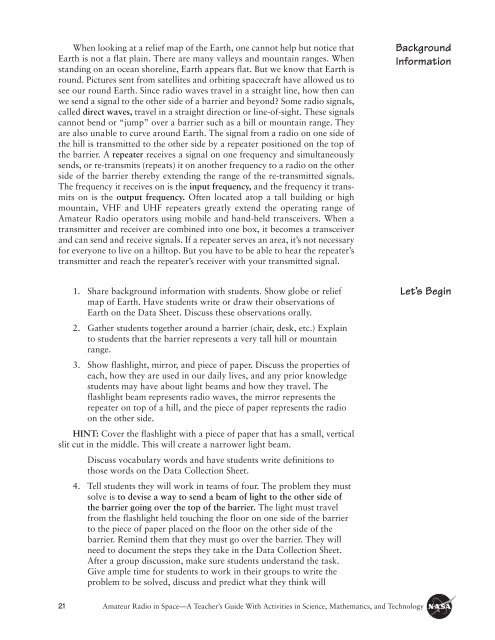Amateur Radio in Space - ER - NASA
Amateur Radio in Space - ER - NASA
Amateur Radio in Space - ER - NASA
- No tags were found...
Create successful ePaper yourself
Turn your PDF publications into a flip-book with our unique Google optimized e-Paper software.
When look<strong>in</strong>g at a relief map of the Earth, one cannot help but notice thatEarth is not a flat pla<strong>in</strong>. There are many valleys and mounta<strong>in</strong> ranges. Whenstand<strong>in</strong>g on an ocean shorel<strong>in</strong>e, Earth appears flat. But we know that Earth isround. Pictures sent from satellites and orbit<strong>in</strong>g spacecraft have allowed us tosee our round Earth. S<strong>in</strong>ce radio waves travel <strong>in</strong> a straight l<strong>in</strong>e, how then canwe send a signal to the other side of a barrier and beyond? Some radio signals,called direct waves, travel <strong>in</strong> a straight direction or l<strong>in</strong>e-of-sight. These signalscannot bend or “jump” over a barrier such as a hill or mounta<strong>in</strong> range. Theyare also unable to curve around Earth. The signal from a radio on one side ofthe hill is transmitted to the other side by a repeater positioned on the top ofthe barrier. A repeater receives a signal on one frequency and simultaneouslysends, or re-transmits (repeats) it on another frequency to a radio on the otherside of the barrier thereby extend<strong>in</strong>g the range of the re-transmitted signals.The frequency it receives on is the <strong>in</strong>put frequency, and the frequency it transmitson is the output frequency. Often located atop a tall build<strong>in</strong>g or highmounta<strong>in</strong>, VHF and UHF repeaters greatly extend the operat<strong>in</strong>g range of<strong>Amateur</strong> <strong>Radio</strong> operators us<strong>in</strong>g mobile and hand-held transceivers. When atransmitter and receiver are comb<strong>in</strong>ed <strong>in</strong>to one box, it becomes a transceiverand can send and receive signals. If a repeater serves an area, it’s not necessaryfor everyone to live on a hilltop. But you have to be able to hear the repeater’stransmitter and reach the repeater’s receiver with your transmitted signal.BackgroundInformation1. Share background <strong>in</strong>formation with students. Show globe or reliefmap of Earth. Have students write or draw their observations ofEarth on the Data Sheet. Discuss these observations orally.2. Gather students together around a barrier (chair, desk, etc.) Expla<strong>in</strong>to students that the barrier represents a very tall hill or mounta<strong>in</strong>range.3. Show flashlight, mirror, and piece of paper. Discuss the properties ofeach, how they are used <strong>in</strong> our daily lives, and any prior knowledgestudents may have about light beams and how they travel. Theflashlight beam represents radio waves, the mirror represents therepeater on top of a hill, and the piece of paper represents the radioon the other side.HINT: Cover the flashlight with a piece of paper that has a small, verticalslit cut <strong>in</strong> the middle. This will create a narrower light beam.Discuss vocabulary words and have students write def<strong>in</strong>itions tothose words on the Data Collection Sheet.4. Tell students they will work <strong>in</strong> teams of four. The problem they mustsolve is to devise a way to send a beam of light to the other side ofthe barrier go<strong>in</strong>g over the top of the barrier. The light must travelfrom the flashlight held touch<strong>in</strong>g the floor on one side of the barrierto the piece of paper placed on the floor on the other side of thebarrier. Rem<strong>in</strong>d them that they must go over the barrier. They willneed to document the steps they take <strong>in</strong> the Data Collection Sheet.After a group discussion, make sure students understand the task.Give ample time for students to work <strong>in</strong> their groups to write theproblem to be solved, discuss and predict what they th<strong>in</strong>k willLet’s Beg<strong>in</strong>21 <strong>Amateur</strong> <strong>Radio</strong> <strong>in</strong> <strong>Space</strong>—A Teacher’s Guide With Activities <strong>in</strong> Science, Mathematics, and Technology
















